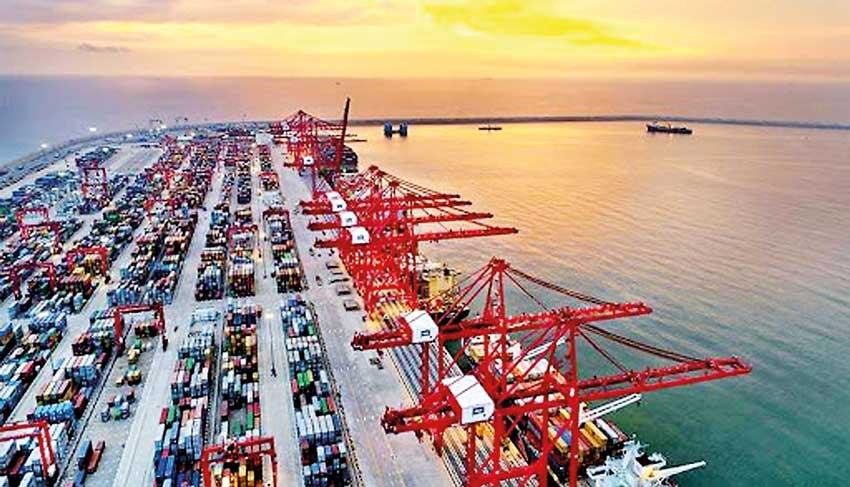23 Sep 2020 - {{hitsCtrl.values.hits}}

By Nishel Fernando
The transhipment container volumes at the Port of Colombo recovered to pre-pandemic levels in July, ending the declining trend recorded since March and leading to an overall recovery of container volumes, according to
Central Bank data.
The container transhipment volumes grew by an impressive 11.4 percent year-on-year (YoY) in July to 519,116 TEUs, as the region’s external trade activities picked up with the pandemic-related travel restrictions easing, particularly in India and Bangladesh.
The Port of Colombo is the second biggest port for Indian containers and with around 70 percent of the port’s transhipment throughput coming from India.
The transhipment throughput started to decline from March, with the escalation of the pandemic globally.
The transhipment throughput at the Port of Colombo declined by 2 percent YoY in March, 22.3 percent YoY in April, 15.8 percent YoY in May and 5.9 percent YoY in June, as India and Bangladesh imposed strict lockdowns and border closures.
With the strong rebound seen in transhipment volumes in July, the decline in overall volumes up to July this year narrowed to 4.2 percent YoY, reaching 3.21 million TEUs.
Meanwhile, domestic container volumes continued to remain well below pre-COVID levels, due to the current import controls in place, although exports have rebounded.
In July, domestic container volumes declined by 17 percent YoY to 86,709 TEUs. However, it showed a slight recovery, compared to 73,329 TEUs handled in June.
In July, the overall container volumes also recovered to pre-pandemic levels, backed by a strong recovery seen in transhipment throughput.
The overall container volumes recorded a 5.7 percent YoY growth in July, handling 618,541 TEUs.
However, restowing volumes declined by 15.2 percent YoY in July.
Colombo International Container Terminal (CICT) was the least affected by the pandemic, compared to the other terminals at the Port of Colombo.
Up to June this year, CICT handled a container throughput of 1.38 million TEUs, with a YoY growth of 0.3 percent.
China Merchant, the parent company of CICT, noted that the terminal saw calling of maiden voyages of large liners through sound commercial efforts, which resulted in higher business volumes and diversification of service routes.
Meanwhile, the bulk cargo volume at the Hambantota Port declined by 60.2 percent YoY to 0.18 million tonnes, mainly due to the impact of the pandemic on the business demand in the hinterland.
However, its RO-RO terminal handled 0.17 million vehicles up to this June, recording a positive growth of 1.4 percent YoY.
The Hambantota Port commenced its fuel oil bunkering service for vessels this April, targeting low-sulphur fuel oil supplies to cargo ships and ocean-going fishing vessels.
The Port of Colombo faces increasing competition, due to India’s plan to set up a transshipment port in the Andaman and Nicobar Islands and due to the delay of executing key expansion projects.
The Ceylon Association of Shipping Agents (CASA) recently warned that the delay in capacity expansion, which includes East Container Terminal (ECT), could jeopardise the Port of Colombo’s transhipment hub status.
The Lakshman Kadirgamar Institute (LKI) in a recent blogspot recommended a private sector-oriented solution to speed up the port expansion projects such as ECT while becoming sensitive to geo-political developments in the region. “A private sector-oriented solution like forming a public-private partnership, through a competitive tendering basis with a multilateral development bank playing an honest broker role, could be one way to approach this issue.
Whatever solution is ultimately adopted, the best possible financial terms for Sri Lanka should be ensured as the Colombo Port is a strategic national asset while considering the sensitivities of the neighbourhood. Seen in purely commercial terms, Sri Lanka’s transshipment trade is heavily dependent on the Indian market and such trade seems at risk,” it elaborated.
18 Nov 2024 2 hours ago
18 Nov 2024 3 hours ago
18 Nov 2024 3 hours ago
18 Nov 2024 4 hours ago
18 Nov 2024 8 hours ago